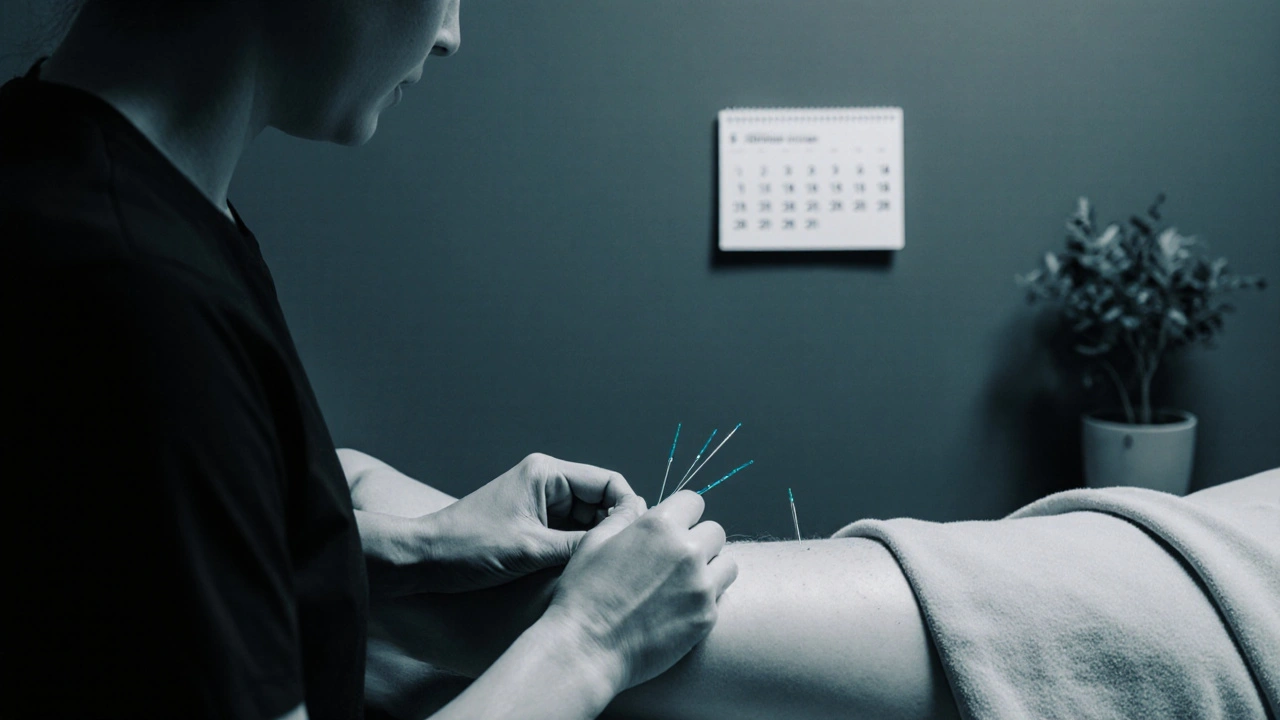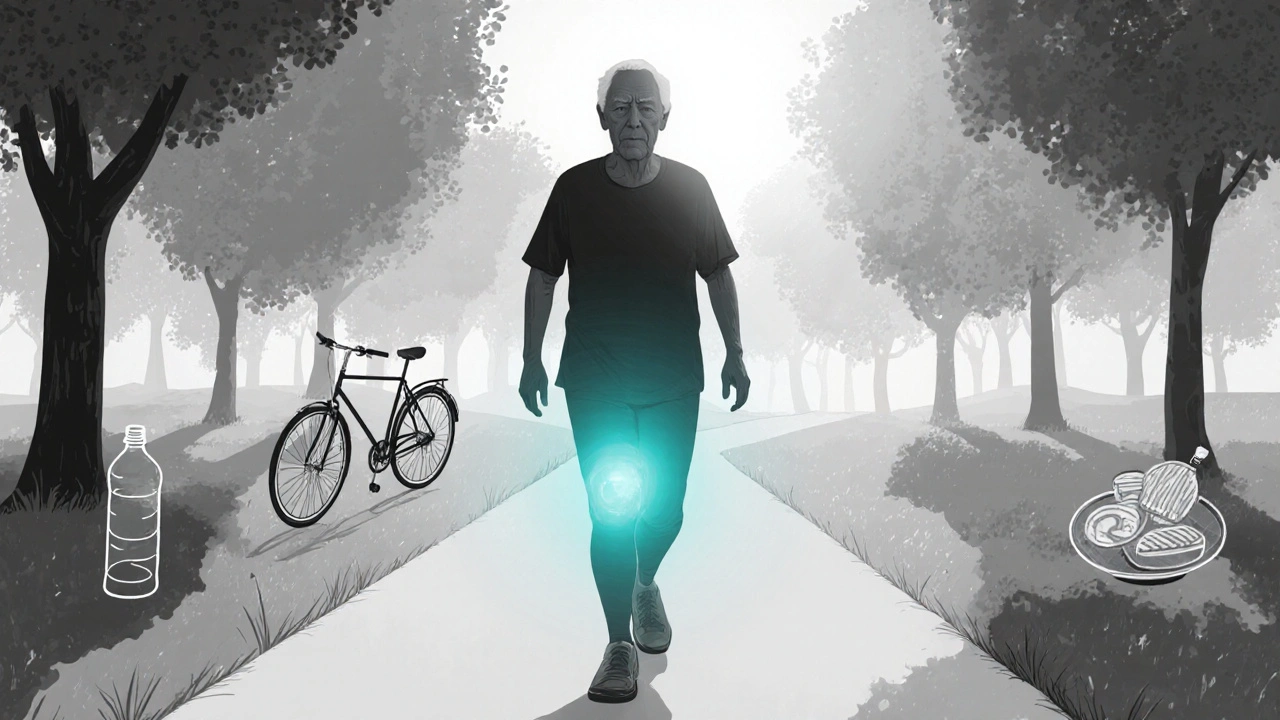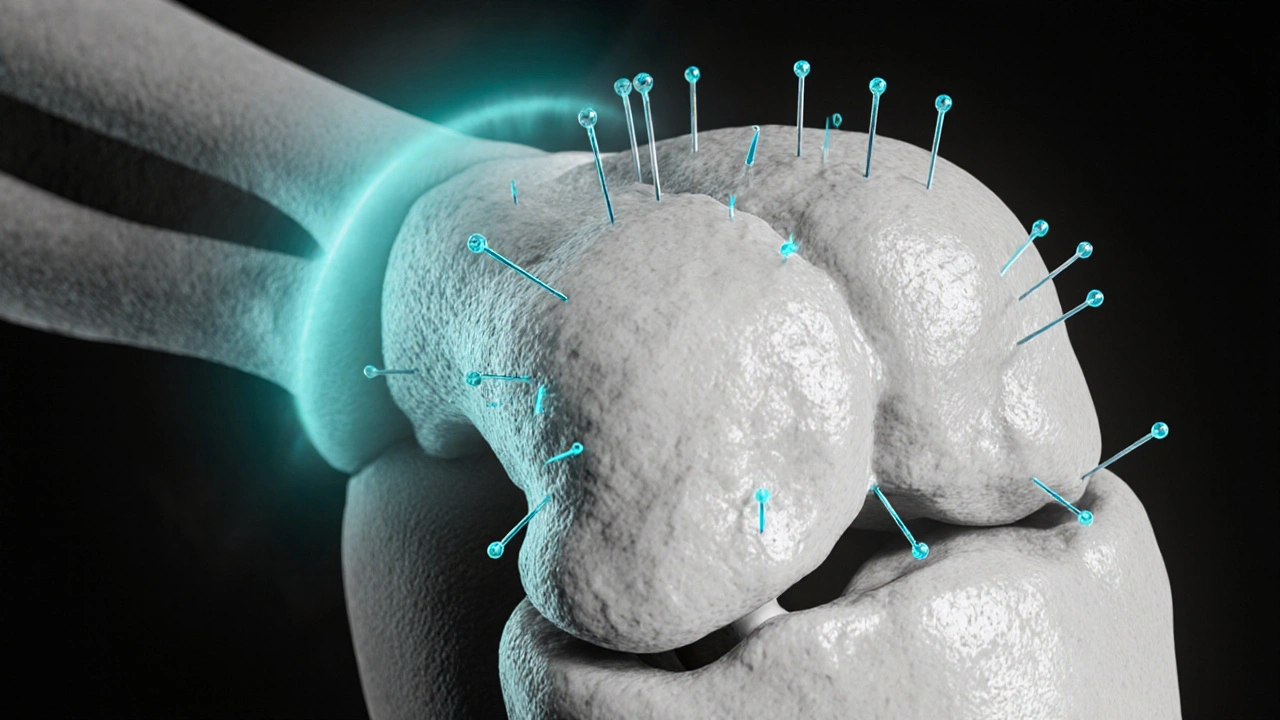Osteoarthritis Pain Relief Estimator
Your Current Pain Level
Rate your osteoarthritis pain on a scale of 0 to 10 (0 = no pain, 10 = worst pain possible)
How It Works
Based on a 2022 meta-analysis of 14 RCTs, acupuncture typically reduces pain by an average of 2.1 points on the 10-point Visual Analog Scale (VAS) compared to sham acupuncture. Results are most significant after 6-12 sessions over 4-8 weeks.
Important: Benefits vary by individual. This tool provides an estimate based on average clinical trial data. Consult your healthcare provider before starting any new treatment.
Estimated Treatment Outcomes
Treatment Comparison
| Feature | Acupuncture | NSAIDs | Physical Therapy |
|---|---|---|---|
| Typical Pain Reduction | 2.1 points | 1.5 points | 1.8 points |
| Session Frequency | 2-3 sessions/week | As needed | 2-3 sessions/week |
| Side Effect Profile | Minor bruising, transient soreness | GI upset, cardiovascular risk | Rare, muscle soreness |
Ever wondered if those tiny needles could actually ease the stubborn joint pain that comes with osteoarthritis? You’re not alone. Many people grab the headlines about acupuncture for osteoarthritis and wonder whether it’s a trustworthy option or just another health fad. Below we’ll break down what osteoarthritis really is, how acupuncture is supposed to help, what the science says, and what you should keep in mind before booking a session.
What is Osteoarthritis?
Osteoarthritis is a degenerative joint disease characterized by the breakdown of cartilage, the smooth tissue that cushions bone ends. As cartilage erodes, bones grind against each other, causing pain, stiffness, and reduced mobility. The condition most often shows up in the knees, hips, hands, and spine. According to the World Health Organization, roughly 10% of men and 18% of women over 60 are dealing with osteoarthritis, and those numbers are climbing as populations age.
Key players in the disease process include inflammation of the synovial membrane, loss of synovial fluid’s lubricating ability, and the formation of bone spurs (osteophytes). While genetics sets the stage, weight, joint injuries, and repetitive stress speed up cartilage degeneration.
How Does Acupuncture Work?
Acupuncture is a core component of Traditional Chinese Medicine that involves inserting thin, sterile needles at specific points on the body to balance energy flow (Qi) and stimulate physiological responses. Modern research suggests the needles may trigger the release of endorphins, modulate inflammatory pathways, and improve local blood circulation.
When a needle hits a point near a painful joint, it can activate sensory nerves that send signals to the brain, prompting the release of natural painkillers like enkephalins. Simultaneously, acupuncture may lower levels of pro‑inflammatory cytokines (e.g., IL‑1β, TNF‑α), which are heavily involved in osteoarthritis pain.
What the Evidence Says
Several clinical trials have examined acupuncture’s effect on osteoarthritis pain, especially in the knee. A 2022 meta‑analysis of 14 randomized controlled trials (RCTs) involving 1,248 participants found that acupuncture reduced pain scores by an average of 2.1 points on the 10‑point Visual Analog Scale (VAS) compared to sham acupuncture. Improvements in function, measured by the Western Ontario and McMaster Universities Osteoarthritis Index (WOMAC), were also statistically significant.
However, not all studies are unanimous. Some smaller RCTs reported modest or no benefit beyond placebo. The variation often stems from differences in needle placement, treatment frequency, and the skill level of the practitioner. Importantly, most high‑quality studies used a minimum of 6-8 sessions over 4-6 weeks, suggesting that a short‑term “one‑time” approach is unlikely to produce lasting relief.

Acupuncture vs. Conventional Treatments
To help you see where acupuncture fits, here’s a quick side‑by‑side comparison of three common osteoarthritis management options.
| Aspect | Acupuncture | NSAIDs (e.g., ibuprofen) | Physical Therapy |
|---|---|---|---|
| Primary Goal | Pain modulation via neuro‑chemical pathways | Reduce inflammation and pain through COX inhibition | Improve joint mechanics and muscle strength |
| Typical Course | 6‑12 sessions over 4‑8 weeks | As needed, often daily dosing | 2‑3 sessions per week for 8‑12 weeks |
| Side‑Effect Profile | Minor bruising, transient soreness | GI upset, cardiovascular risk, kidney strain | Rare, but over‑use can cause muscle soreness |
| Evidence Strength | Moderate (meta‑analyses show benefit) | Strong (large RCTs, guideline‑supported) | Strong for function, moderate for pain |
| Cost (Australia, 2025) | AU$70‑$100 per session | AU$5‑$15 per pack (over‑the‑counter) | AU$90‑$130 per session |
Acupuncture generally shines when patients cannot tolerate NSAIDs due to gastrointestinal or cardiovascular issues, or when they want a non‑pharmacologic option that also addresses overall well‑being.
Practical Considerations: Finding a Qualified Practitioner
- Credentials: In Australia, look for practitioners registered with the Australian Acupuncture and Chinese Medicine Association (AACMA) or holding a degree from an accredited university.
- Safety: Proper sterilization is a must. Most reputable clinics use single‑use, disposable needles.
- Session Frequency: Expect an initial assessment, followed by a series of treatments spaced 2-3 days apart.
- Insurance: Some private health funds cover acupuncture for chronic pain; check your policy.
Side effects are rare but can include mild bruising, temporary fatigue, or faintness. Serious complications, such as organ puncture, are exceedingly uncommon when performed by trained professionals.
Who Stands to Gain the Most?
Evidence suggests certain sub‑groups respond better:
- Knee osteoarthritis: Most RCTs focus here, showing consistent pain reduction.
- Patients on anticoagulants: Acupuncture is often safe, but inform your practitioner.
- Older adults with polypharmacy: A needle‑based approach can lower reliance on multiple drugs.
- Individuals seeking holistic care: Acupuncture aligns with lifestyle changes like diet and gentle exercise.
That said, anyone with severe joint deformity or acute inflammation should first consult an orthopaedic specialist before adding acupuncture to the regimen.

Potential Pitfalls and How to Avoid Them
- Expecting instant miracles: Benefits usually accumulate after several sessions.
- Skipping the evaluation: A thorough history and physical exam help tailor point selection.
- Choosing cheap, unlicensed providers: Low cost often means compromised hygiene and skill.
- Ignoring other therapies: Acupuncture works best as part of a multimodal plan that includes exercise, weight management, and, when needed, medication.
Frequently Asked Questions
Frequently Asked Questions
Is acupuncture covered by Australian Medicare?
Medicare does not cover acupuncture, but many private health insurers subsidise a limited number of sessions each year. Check your policy’s “chronic disease” or “alternative therapy” benefits.
How many sessions will I need?
Most studies use 6‑12 sessions over 4‑8 weeks. Individual response varies, so your practitioner will adjust the plan based on pain levels and functional gains.
Can I combine acupuncture with my current NSAID regimen?
Yes, many patients start acupuncture while still using NSAIDs, then taper the meds as pain eases. Always coordinate with your GP or rheumatologist.
Are there any contraindications?
Avoid acupuncture over areas with active infection, open wounds, or severe bleeding disorders. Pregnancy‑related points require special care.
What should I expect during a session?
After a brief assessment, the practitioner will insert thin needles into specific points around the affected joint. You’ll feel a mild tingling or heaviness, then rest for about 20‑30 minutes while the needles stay in place.
Bottom line: Acupuncture isn’t a miracle cure, but solid evidence backs its role as a safe, drug‑free option that can trim pain and improve joint function for many osteoarthritis sufferers. Pair it with a balanced diet, regular low‑impact exercise, and medical guidance, and you’ll have a comprehensive plan that tackles the problem from multiple angles.

Lauren Sproule
October 16, 2025 AT 20:33I’ve seen a few folks try acupuncture for knee aches and many swear by it especially when they can’t pop pills all day. It seems to calm the joint by hitting those pressure points and letting the body release its own painkillers. If you find a certified practicioner it’s worth a shot before upping the meds.
Patricia Echegaray
October 22, 2025 AT 18:57Look, the big pharma cartel don’t want you to know that needles can actually dial down inflammation they hide the truth behind the glossy ads. In the land of the free we should demand real alternatives instead of swallowing sugar‑coated pills. The old Chinese ways are not a fad they’re a rebellion against the chemical empire.
lisa howard
October 28, 2025 AT 16:21When I first walked into the clinic I felt like I was stepping onto a movie set, the lights dimmed, the scent of incense swirling around like a prophecy. The practitioner said the needles would “talk” to my knee and I imagined tiny soldiers marching through my joint, firing off endorphins like fireworks. Each poke was a tiny sting that felt oddly empowering, as if I were being stitched back together by invisible threads. The room was silent except for the soft hum of a distant fan, and my mind raced with memories of every ache I’d ever ignored. With every minute the needles stayed in, I sensed a slow melt of tension, a quiet surrender to something ancient. By the end of the session I was drenched in sweat, not from pain but from a bizarre, euphoric release that left me trembling. The therapist handed me a sheet of paper outlining a schedule of six to eight sessions, and I could almost hear the chorus of my joints cheering. I left the building feeling like a warrior who had just survived a battle against his own body, bruised but unbowed. The next days I noticed my knee flexing a little easier, like a reluctant hinge finally finding its groove. Friends asked if I was on some new miracle drug, and I laughed, saying no, just a few needles and a lot of hope. The scientific papers on the wall spoke of cytokine reduction, but in my head the drama was far more vivid than any graph. I kept a journal, noting pain levels each morning, and the numbers fell like dominoes, one after another. The whole experience felt like a rite of passage, a test of faith in something beyond pills. Even my sceptical brother called me after a month to say he was impressed, which felt like a badge of honor. Looking back, the whole saga taught me that healing can be theatrical, and sometimes a little drama is exactly the medicine we need.
Cindy Thomas
November 3, 2025 AT 14:45Some folks rave about the needle buzz and call it a miracle, yet the data still shows a mixed bag and we can’t ignore the placebo horsepower at play :) It’s fine to try, but don’t let hype replace solid rehab work.
James Falcone
November 9, 2025 AT 13:09Sounds like a decent plan.
Frank Diaz
November 15, 2025 AT 11:33While the smiley face hides a deeper yearning for quick fixes, we must scrutinize the methodology behind each trial and ask whether the subtle neurochemical shift truly outweighs the cumulative evidence of structured physiotherapy.
Emily (Emma) Majerus
November 21, 2025 AT 09:57Hey, if you’re thinking of giving acupuncture a go, pick a legit clinic, log your pain scores, and combine it with gentle exercise for best results.
Virginia Dominguez Gonzales
November 27, 2025 AT 08:21Imagine the needles as tiny guides leading your joints back to harmony, each session a stepping stone toward reclaiming freedom from that stubborn creak.
RJ Samuel
December 3, 2025 AT 06:45Truth is, most of the hype around needles is just a circus act to keep the big pharma cash flowing while they chase after the next shiny gadget.
Rebecca Mitchell
December 9, 2025 AT 05:09It’s a slick marketing spin that distracts from real lifestyle changes.
Roberta Makaravage
December 15, 2025 AT 03:33Let’s be clear: cherry‑picking a few favorable studies while ignoring the larger body of evidence is intellectually dishonest 🙅♀️. Ethical practice demands we weigh both benefits and risks before urging anyone into an alternative modality.